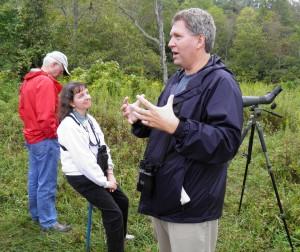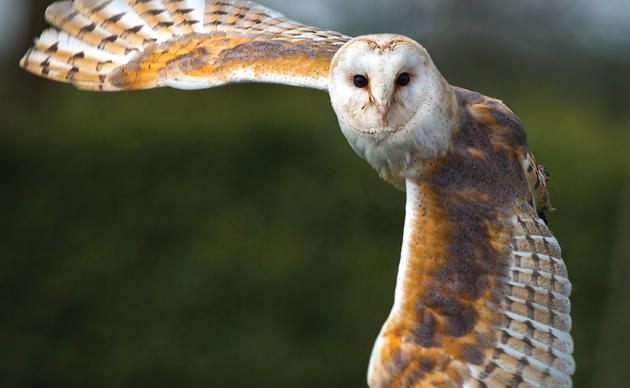Audubon North Carolina has an amazing staff across the state dedicating their time and expertise to protecting birds and their habitats, and engaging others to support bird conservation efforts. In this blog series, we will introduce you, our supporters, to the names and faces behind Audubon NC.
Curtis oversees our Saving Important Bird Areas, Putting Working Lands to Work for Birds and People and Bird-Friendly Communities initiatives, and works on energy policy issues for our Shaping a Healthy Climate Initiative. He also engages dozens of conservation partners regionally, nationally and internationally to ensure North Carolina’s birds are protected throughout their entire annual life cycle.
Describe your job with Audubon NC.
I often provide data on a wide variety of bird species to our partners, members, chapters, land managers, property owners, decision makers and regulators. This might be data about where birds occur, how many there are, and scientifically supported best practices to conserve them. Where data doesn’t yet exist, I work to find them or support the work of others collecting this information. Not as much is known about birds as people might think. That is why Audubon’s work as a science organization is so important. We collect and analyze that data through many methods including our citizen science projects like the Great Backyard Bird Count and Hummingbirds at Home.
What inspired you to pursue a career in conservation?
My grandfather, but I have always liked birds, and from an early age, started to identify them by sight and by ear. Even more, I like to study them. I am really curious why they do what they do and how they do it.
What brought you to work with Audubon NC for the benefit of birds?
A mentor at Appalachian State University, Dr. Matt Rowe, recommended me to Walker Golder, Deputy Director of ANC, for some survey work on Golden-winged Warblers. I was not working in conservation at the time, and Dr. Rowe felt I could benefit from getting back to what I really loved to do. That part-time work developed into a full-time career studying the birds that I already loved.
Why do you feel it’s important to protect and conserve birds in North Carolina? Globally?
The basic answer is that we need to do all we can to preserve biodiversity. We have a responsibility to conserve what we have, and work to understand why some species are doing poorly and others are thriving. It gets really complicated really quickly, and having a firm, science-based knowledge of what is going on out there is core to making good choices. Humans are guilty of creating unintended consequences as a result of our actions.
Being the voice for the birds that are affected by these actions allows our partners, members and policy makers to make more informed decisions and choices.
Because birds move to different areas during the course of a year through migration to nest, and to rest during the winter, we need to follow them where they go, and help our partners protect all the areas the birds need across the globe to be successful. In bird terms, success is measured by having chicks that grow into adulthood to breed more of that species. That is what ensures species survival. We can only accomplish this level of protection by working globally. For example, Audubon North Carolina’s work in Nicaragua is helping to answer basic science questions while at the same time trying to tie those answers to protecting and improving human lives.
How is your work with Audubon specifically helping to protect birds in NC? What particular birds does your work help protect?
I think my work helps protect birds in two major ways. The first is direct habitat impact. Our programs to protect the Golden-winged Warbler working with private landowners to manage their land help these and other birds through our Working Lands initiative for mature forest. We work with public and private landowners to implement bird-friendly practices on those lands, which results in protection of important bird habitats for the benefit of specific birds.
The second area is providing science-based expertise to planning efforts – such as for the state and national parks and forests - and policy efforts like energy siting, In both cases, we identify and work to moderate threats to birds and habitats. I serve on several working groups that advance our understanding of priority species, but I also serve on committees that help shape policy like the state taxa team of the scientific council that sets species conservation priorities for the state of North Carolina. These activities are critical to helping advance sound science and bird protection priorities in the state.
What is your favorite bird? Why?
Whichever one I am studying at the moment! Right now it would be Golden-winged Warblers, but I am also fond of Wood Thrushes and Yellow-bellied Sapsuckers (which I have also intensively studied). I think the reason for this is that with an intimate knowledge and understanding of their lives I gain real respect for the difficult lives they lead.
For example, just think about a bird weighing the same as four quarters that flies a 4,000-mile round-trip migration to return each year. That is a truly phenomenal feat, really spectacular. We don’t appreciate that enough.
What is the most exciting bird you’ve ever spotted? What happened?
A new lifer (a bird seen for the first time in your life) is always cool and exciting! My most recent lifer was a Stub-tailed Spadebill in Nicaragua. This is a very small, very plain, dense habitat flycatcher. Hard to see and cool to find. I would also say that any bird we band that migrates away, then comes back and is re-sighted is always a thrill. It’s like seeing an old friend. I am fortunate that I work on projects where I get to see that almost every year.
While in Nicaragua this year our partners recaptured a Golden-winged Warbler that was banded in Illinois during migration. This was the first foreign recapture of a Golden-winged Warbler ever on the wintering grounds. It was cool to see that bird and know that he connected the dots for us. We have deployed geolocators on him, so we might learn where he is breeding next year as well. Pretty cool stuff.
What advice do you have for someone interested in becoming involved with bird conservation efforts?
Volunteer. Learn as much as you can about the things that interest you. Become a citizen scientist, and don’t be afraid that you don’t know enough or can’t help. You can.

What would you like people to know about birds that they may not already know?
Birds are out there living their lives. And they are not abstract lives. They have babies. They migrate back and forth to their homes. They think, they feel pain, and many live longer than you might suspect. This is what makes conservation so important. Our lives intersect with theirs. It is up to us to respect that.
For example a Wood Thrush can live to be 10 years old. Every year when it flies back from the tropics, he and his mate have to have a place to raise their young. Much of the time they return to the very same spot. It is truly their home. If we change that home by constructing something or cutting down trees, they have to find a new home. That gives us some responsibility for providing that new home or maintaining the one they are returning to.
Curtis is a 1985 magna cum laude graduate of Appalachian State University with a Bachelor of Arts in Biology and in 1996 received a Master of Arts in Appalachian Studies. He is a 2005 National Audubon Society ACE Award winner for outstanding contributions to bird conservation, and is a 2008 Extra Effort Award Winner from North Carolina Partners in Flight.
Curtis’ Publications
- Dolly L. Crawford 1*, Ronald W. Rohrbaugh2 , Kyle R. Aldinger3, Sara Barker Swarthout2, David A. Buehler4, John Confer5, Christian Friis6, Jeff Larkin7, Irby Lovette8, James D. Lowe2, Martin Piorkowski9, Kenneth V. Rosenberg2, Amber Roth10, Curtis Smalling11, Petra Bohall Wood12, Rachel Vallender. 2015. Spatio-temporal variation in the distribution of Golden-winged Warbler and Blue-winged Warbler as a function of climate; implications for management and conservation. In prep.
- Jones, John A., Anna Tisdale, Curtis Smalling, and Lynn Siefferman. 2015. Ecological and behavioral consequences of sympatry between golden-winged and chestnut-sided warblers in the southern Appalachians. In prep.
- Theron Terhune II, et al. 2015. Effects of Golden-winged Warbler management on other species. In prep.
- King, David, Richard Chandler, Curtis Smalling, and Tom Will. 2015. Non-breeding Golden-winged Warbler Habitat: Status, Conservation, and Needs. In press. Studies in Avian Biology.
- Aldinger, Kyle R., et al. 2015. A BROAD GEOGRAPHIC ASSESSMENT OF FACTORS CORRELATED WITH GOLDEN-WINGED WARBLER REPRODUCTIVE PARAMETERS. In press. Studies in Avian Biology
- Buehler, Dave, et al. 2015. Golden-winged Warbler Nest-site Habitat Selection. In press. Studies in Avian Biology
- Aldinger, Kyle, et al. 2015. AN ASSESSMENT OF VARIABLES ASSOCIATED WITH GOLDEN-WINGED WARBLER NESTING PARAMETERS. . In press. Studies in Avian Biology
- Chandler, Richard, et al. 2015. CONSERVATION IMPLICATIONS OF GOLDEN-WINGED WARBLER SOCIAL AND FORAGING BEHAVIORS DURING THE NONBREEDING SEASON. In press Studies in Avian Biology
- Contributing author to the Bird Finding Guide to North Carolina (Falcon Press, 2005), Exploring North Carolina’s Natural Areas (Dirk Frankenberg, ed., UNC Press 2000) as well as co-author of the Compact Guide to the Birds of Virginia (Lone Pine, 2006), the Compact Guide to the Birds of North Carolina (Lone Pine, 2006), and the Compact Guide to the Birds of South Carolina (Lone Pine, 2007), and the Illustrated Birds of North Carolina (Rocky Publications, 2011).
Curtis serves on the following committees and boards:
- Elk Knob State Park Advisory Committee
- Friends of High Country State Parks
- Golden-winged Warbler Working Group
- Alianza Alas Doradas
- Cerulean Warbler Technical Working Group
- El Grupo Ceruleo
- Southern Appalachian Yellow Bellied Sapsucker Working Group
- International Wood Thrush Conservation Alliance
- Eastern Golden Eagle Working Group
- Appalachian Mountains Joint Venture Technical Committee
- Appalachian Mountains Landscape Conservation Cooperative Taxa Rep
- NC State Wildlife Action Plan Revision Taxa Team Member
- NC Scientific Council Bird Taxa Team
- NC Wind Energy Working Group
- Atlantic Flyway Eastern Forests Project – Forest Block mapping lead
- Atlantic Flyway Grassland and Shrubland Project
- NC Bird-Friendly Communities Implementation Team
- NC Forest Land Bird Legacy Project
- NC Partners in Flight
- NC Birding Trail
Want to learn more about the team members of Audubon North Carolina? Click here to continue our staff profile series.



